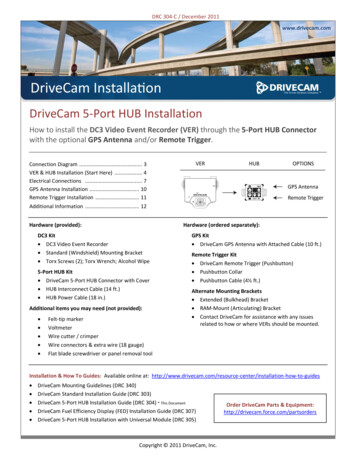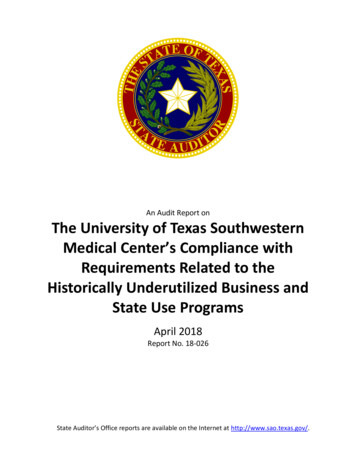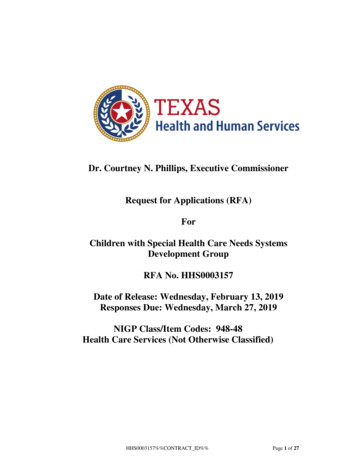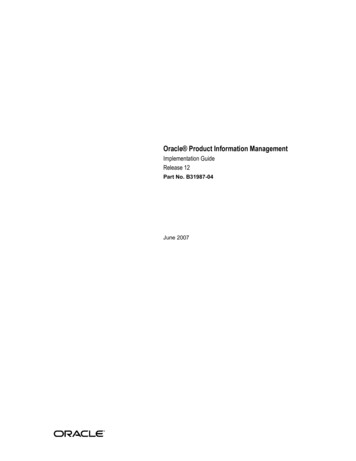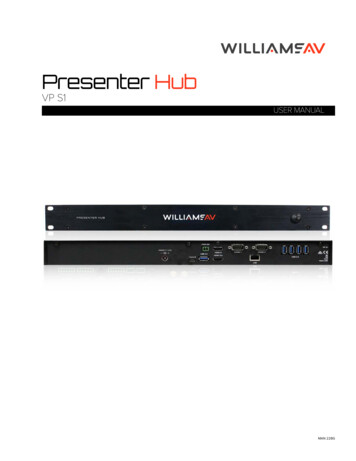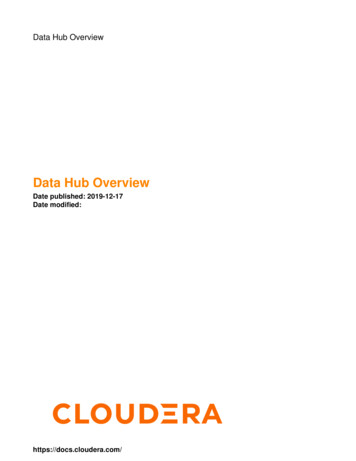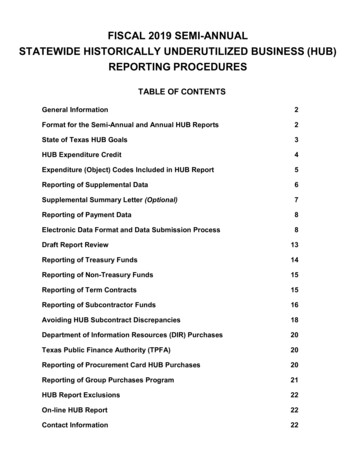
Transcription
FISCAL 2019 SEMI-ANNUALSTATEWIDE HISTORICALLY UNDERUTILIZED BUSINESS (HUB)REPORTING PROCEDURESTABLE OF CONTENTSGeneral Information2Format for the Semi-Annual and Annual HUB Reports2State of Texas HUB Goals3HUB Expenditure Credit4Expenditure (Object) Codes Included in HUB Report5Reporting of Supplemental Data6Supplemental Summary Letter (Optional)7Reporting of Payment Data8Electronic Data Format and Data Submission Process8Draft Report Review13Reporting of Treasury Funds14Reporting of Non-Treasury Funds15Reporting of Term Contracts15Reporting of Subcontractor Funds16Avoiding HUB Subcontract Discrepancies18Department of Information Resources (DIR) Purchases20Texas Public Finance Authority (TPFA)20Reporting of Procurement Card HUB Purchases20Reporting of Group Purchases Program21HUB Report Exclusions22On-line HUB Report22Contact Information22
GENERAL INFORMATIONAccording to Texas Government Code, Chapter 2161, the Office of the Comptroller of Public Accounts(CPA) is responsible for managing the Statewide Historically Underutilized Business (HUB) Program forminority- and women-owned businesses. CPA is required to compile a semi-annual and annual report ofcontracts awarded to HUBs by state agencies and institutions of higher education. The report documentsexpenditures in six (6) procurement categories identified as Heavy Construction, Building Construction,Special Trade, Professional Services, Other Services and Commodities. The report also documents thetotal dollar amount of contracts awarded. This report must be submitted to the presiding officer of eachHouse of the Legislature and the Joint Committee.Electronic versions of the HUB Reports are available on-line free of charge hub/reporting.phpHUB REPORT FORMATThe format for the HUB Report reflects six (6) procurement categories. The report shows one state agencyor institution of higher education per page. The comptroller object (expenditure) codes that are inclusive tocompiling the HUB Report are identified on Attachment A.The HUB Report contains total expenditure data for treasury, non-treasury, subcontracting, grouppurchasing, term contract, and procurement card purchases. It is the responsibility of each state agencyand institution of higher education to ensure the accuracy of their expenditure and supplementaldata (e.g., treasury, non-treasury, credit card, subcontracting, bond issuance, bids and proposalsreceived, and competitive and non-competitive contracts awarded).Following the procedures herein, each state agency and institution of higher education will report their nontreasury, subcontracting, group purchasing, term contract, and procurement card 252/checkout/login.ssp?n 2&login T#login-registerTheComptroller’s Office shall report the treasury expenditures of each state agency and institution of highereducation.Object codes for benefits, claims and judgments, interfund transfers, interagency payments, investments,payment of interest, payment of principal, public assistance payments, rentals and leases, utilities, salaries,wages, travel, grants, scholarships, real estate purchases, rights-of-way, emergency abatement response,and other expenses, as determined by the 2009 State of Texas Disparity Study (as defined by 34 TAC §20.281), will be excluded from the HUB Report.See Attachment A for a list of Comptroller object codes used to prepare the HUB Report. Expendituresmust be reported to the CPA according to the following legislatively mandated timelines. If the due date forthe HUB Report expenditure data falls on a weekend, all data will be due on the Friday before the weekend.The treasury, non-treasury, subcontract, and term contract data received for the semi-annual reportingperiod (September 1 - February 28 or 29) and the annual reporting period (September 1 - August 31) of thecurrent Fiscal Year will be compiled by the CPA. The system electronically cross references the State'scertified HUB Directory to search for the first 11 digits of the Vendor Identification Number (VID). All VIDnumber matches will be used to record the state agencies’ and institutions’ total dollar amount of contractsawarded to certified HUB vendors.2
The HUB Report identifies for each state agency, institution of higher education, and the State as awhole, the total expenditures with all vendors, the total spent with Non-HUBs, and the total spent withcertified HUBs. The CPA Statewide HUB Program certifies businesses by ethnicity and gender and byservice disabled veteran status. Minority men and women certified as HUBs are counted as an ethnicminority. The "American Woman" category includes all American Women other than Black American,Hispanic American, Asian-Pacific American, Native American or Service-Disabled Veteran.HUB Eligible Groups are identified as follows:AIASBLHIDVWO Native American;Asian-Pacific American;Black American;Hispanic American;Service-Disabled Veteran; andAmerican WomanData for the consolidated total expenditures, (treasury, non-treasury, subcontracting, delegated, openmarket, term contracts, emergency, proprietary, catalogue, exempt, etc.) must be reported to the CPAaccording to these reporting procedures and legislatively mandated timelines.SEMI-ANNUAL REPORTING PERIODSeptember 1 through February 28 or 29 of the current Fiscal YearState Agency/Institution of Higher Educationth HUB Report Data Submittal DeadlineMarch 15 of the current Fiscal Year CPA HUB Report Due DateMay 15 of the current Fiscal YearthANNUAL REPORTING PERIODSeptember 1 through August 31 of the current Fiscal YearState Agency/Institution of Higher Educationth HUB Report Data Submittal DeadlineSeptember 15 of the current Fiscal Year CPA HUB Report Due DateNovember 15 of the current Fiscal YearthSTATE OF TEXAS HUB GOALSThere are six procurement categories and each procurement category has a HUB goal (see table below).The six procurement categories and HUB goals are from 34 TAC § 20.284. Pursuant to Section2161.002(c), the HUB goals are based on the 2009 State of Texas Disparity Study.For more details on HUB Goals, please refer to 34 TAC § 20.284Procurement CategoryHUB GoalHeavy Construction11.2%Building Construction21.1%Special Trade32.9%Professional Services23.7%Other Services26.0%Commodity Purchases21.1%3
HUB EXPENDITURE CREDITState agencies and institutions of higher education will receive HUB credit for payments made to HUBscertified by the CPA within the reporting period. Certification is determined by verifying that the 11-digitVID number used for HUB certification matches the 11-digit VID number used for issuing the purchaseorder and making the payment. Representatives of the Statewide HUB Program may access theComptroller's Texas Identification Number System (TINS) to verify the payment history under the VIDnumber submitted by the vendor on the HUB certification application. (This verification does notautomatically confirm the correct assigned VID).If a state agency or institution of higher education determines that there is a discrepancy between the VIDnumber identified in the HUB Directory, TINS and/or their payment records, the agency/institution ofhigher education should notify the vendor, and also contact a representative of the Statewide HUBProgram at 512-463-5872 or 1-888-863-5881. Research will be conducted by the CPA, and the vendorrecord will be updated accordingly. CPA will notify the requesting entity regarding the correct VID numberfor the certified HUB. The CPA and the agency's Accounting Office must also update the vendor's record. HUB CREDIT - State agencies and institutions of higher education will receive HUB credit forpayments made to 11-digit VID numbers that were a certified HUB for any period of time during thecurrent fiscal year’s reporting period. Payments meeting this criterion are added to the totalexpenditure column and HUB expenditure column. NO HUB CREDIT - State agencies and institutions of higher education will not receive HUB creditfor payments made to 11-digit VID numbers that were not a certified HUB for any period of timeduring the current fiscal year’s reporting period. Payments meeting this criterion are added to the totalexpenditure column and are considered to be Non-HUB expenditures.If a vendor’s HUB status was active (i.e. HUB status code “A”) for any period of time during the currentfiscal year’s reporting period, state agencies and institutions of higher education will receive HUB creditfor the payments that were awarded to the HUB vendor during the entire fiscal year (retroactive).There are eleven Status Codes in the CPA HUB Directory. These status codes are identified below:ADGO-Active*Decertified*Graduated*Old VID Number*IMNP-Inactivated*Returned Mail*Not HUBPendingR - RejectionV - Vendor Requested Removal*X - Audit Removal**Note: Provided that the VID number was HUB certified/active during the current fiscal year’s reportingperiod, state agencies and institutions of higher education will receive HUB credit for payments made toVID numbers displaying these HUB status codes.State agencies and institutions of higher education are encouraged to reference the “HUBs ActiveDuring Current Fiscal Year Master File (hub name.dat)” online athttps://comptroller.texas.gov/purchasing/ which is a list of vendors who have been a Texas certifiedHUB (i.e., HUB status code “A”) for at least one day during the current fiscal year. For the purposes ofproducing the HUB Reports, payments that are awarded during the current fiscal year to the VendorID Numbers contained within this file will be counted as HUB expenditures.4
EXPENDITURE (OBJECT) CODES INCLUDED IN HUB REPORT (ATTACHMENT A)The object codes included in the HUB Report were reviewed and developed by a subcommittee of theHUB Cooperative Committee, which evaluated all existing Comptroller object codes. The subcommitteereviewed each object code definition and made a determination whether to include or exclude the objectcode. The selection criteria allows and includes all object codes that pertain to the purchase of goods,services, and public works contracts and excludes all object codes that pertain to benefits, claims andjudgments, interfund transfers, interagency payments, investments, payment of interest, payment ofprincipal, public assistance payments, rental and leases, utilities, salaries, wages, travel, grants,scholarships, real estate purchases, right-of-way, emergency, abatement response, and other expensesas determined by the 2009 State of Texas Disparity Study. Total expenditures are awarded contracts withallowable object codes, which are actually paid from treasury and non-treasury funds. This includesdelegated, open market, term contract, proprietary, emergency, and exempt purchases.The 2009 State of Texas Disparity Study used a list of object codes and corresponding procurementcategories to identify results of state agency expenditures and utilization of HUBs. The CPA includesthese object codes as part of the HUB Report.For the purpose of the HUB Report, an object code is either entirely included or entirely excluded.Therefore, if a contract is awarded under an excluded object code, then HUB credit cannot be receivedbecause the contract dollars are not part of the state agency's or the institution's total expenditures. CPAencourages the state agencies and institutions to seek creative options to report good faith efforts andcontract opportunities from the excluded object codes. It may require state agencies and institutions toshift from the current way of coding an excluded contract by breaking down the contract and usingincluded object codes for coding part of the contract. See the examples below:Example #1: 7666 - Medical Services and Specialties - The Health and Human Services Commission(HHSC) has a large client service contract with National Heritage Insurance Company (NHIC). NHIC isthe Health Care Financing Program's Prime Contractor for processing insurance claims for the TexasMedicaid Program. This contract is classified under object code 7666 (an exempt code). NHICsubcontracted part of the contract with a HUB. Since the NHIC contract is not part of the base for thisstate agency's or the institution's total expenditures, HUB subcontracting cannot be reported. In order forHHSC to receive HUB subcontracting credit, all expenditures under 7666 must be included, not just theNHIC contract. This would adversely affect HHSC's overall percentage and would greatly influence otherstate agencies and institutions as well. For example, the NHIC contract could be coded as follows:If the NHIC contract was a 10 million contract and the actual payments made by NHIC to clients formedical reimbursements were 7 million, the remaining 3 million would be the amount paid to NHIC foradministering this client reimbursement contract. CPA proposes that only 7 million (actual clientreimbursements) should be coded as 7666. The other 3 million should be coded under an object codefrom the list of object codes used to compile the HUB Report which will best describe the service thatNHIC is performing. All questions regarding expenditure codes should be directed to the Comptroller'sOffice, Claims Division, at 512-463-4850. Any other contracts with related administrative fees must beincluded under the same selected object code so that HHSC can hold NHIC accountable forsubcontracting with HUBs. HHSC can then submit the HUB subcontractor dollars and receive credit onthe HUB Report.Example #2: 7462 - Rental of Office Buildings or Office Space - HHSC has very large leasingcontracts throughout the state. The expenditure (object) code for leasing (7462) is currently exempt fromthe HUB Report. However, within a lease contract, there are contracting opportunities where a good faitheffort could be made. A lease contract can be broken down to reflect the actual services performed withinthe contract. For example, at a minimum, the following object codes could be used to report servicesincluded in a full lease or a net lease contract: 7277 - Cleaning Services; 7271 - Real Property - Land Maintenance and Repair - Expensed; and 7266 - Real Property Buildings - Maintenance and Repair- Expensed.Breaking down the lease contracts with these included expenditure codes allows HHSC to hold the lessoraccountable for subcontracting with HUBs. HHSC can now be measured on all transactions that arewithin the included expenditure codes and receive full credit through the HUB Report for their committedefforts. All subcontracting must be reported under the same object code under which the PrimeContractor was paid.5
REPORTING OF SUPPLEMENTAL DATAIn accordance with Texas Government Code § 2161.122, state agencies and institutions of highereducation shall report the following information to the CPA. Historically Underutilized Business (HUB)information must be reported by ethnicity and gender. The supplemental data must be submitted on-linethrough the HUB Reporting System out/login.ssp?n 2&login T#login-registerApproximately mid-February and mid-August, as a courtesy, the CPA’s Statewide HUB Program will sendthe state agencies and institutions of higher education reminder notices for the submission of their semiannual and annual HUB Report data, respectively.- BUSINESSES PARTICIPATING IN STATE BOND ISSUANCES(Applicable to State Bond Issuers Only)State agencies and institutions of higher education who issue bonds are required to report to theCPA the total number of businesses (HUB and Non-HUB) that participate in bond issuances.- HUBS SUBMITTING BIDS / PROPOSALSAll state agencies and institutions of higher education are required to report to the CPA the totalnumber of HUBs and Non-HUBs submitting bids and/or proposals for the purchase of goods andservices.The types of bids (quotes, offers, or other applicable expression of interest) and proposals include: Delegated Purchases, including informal and formal bidsOpen Market BidsInformation Technology Bids / ProposalsRequest for Proposals / Competitive Sealed ProposalsEmergency BidsProprietary Bids/Sole SourceTerm Contract Bids (applicable to CPA’s Statewide Purchasing Division)Scheduled Purchase Bids (applicable to CPA’s Statewide Purchasing Division)- NUMBER OF CONTRACTS AWARDEDAll state agencies and institutions of higher education are required to report to the CPA the totalnumber of contracts awarded (HUB and Non-HUB) for the purchase of goods and services. The totalcontract awards MUST not exceed the Total number of Bids/Proposals received by theagency/institutions of higher education.The number of contracts awarded to HUBs should include: Delegated PurchasesOpen Market PurchasesInformation Technology PurchasesEmergency PurchasesProprietary Purchases/Sole SourceTerm Contracts (applicable to CPA’s Statewide Purchasing Division)Scheduled Purchases (applicable to CPA’s Statewide Purchasing Division)Note: For the purposes of reporting contracts, state agencies and institutions of higher educationshould not report purchases that were made using the state procurement card. These purchases arenot individual contracts for the purpose of HUB Reporting. Individual requisitions against a blanketpurchase order or against an IDQ (Indefinite Delivery Quantity) should not be counted as individualcontracts.6
SUPPLEMENTAL SUMMARY LETTER (Optional)In accordance with 34 TAC § 20.284(e), state agencies and institutions of higher education may alsodemonstrate good faith under this section by submitting a supplemental letter with documentation to the CPAwith its HUB Report or legislative appropriations request identifying its progress, including, but not limited tothe following, as prescribed by the CPA: Identifying the percentage of contracts awarded to women-, minority- and/or service-disabledveteran-owned businesses that are not certified as HUBs;Demonstrating that a different goal from that identified in § 20.284(b) was appropriately given forthe state agency's/institution’s mix of purchases;Demonstrating that a different goal was appropriately given for the particular qualifications requiredby the state agency/institution for its contracts; orDemonstrating assistance to non-certified HUBs in obtaining certification with the CPA.The Supplemental Letter must outline a state agency’s or institution of higher education’s good faith effortregarding procurement opportunities for HUBs. The Supplemental Letter should provide a comprehensiverepresentation of the state agency's/institution’s efforts and may address any unique purchasing requirementsnot directly reflected within the totals and percentages.Supplemental Letters are limited to one page (front side only) on the state agency’s/institution’s officialstationary letterhead.oThe first line should be the reference line, including the state agency's/institution’s 3-digitidentification number. EXAMPLE: "999 - Fiscal 2018 Annual HUB Report Supplemental Letter";oDo not include date, and address, or salutation line;oFont size should be at least 10 point, and Margins should be at least 1 inch;oThe letter must be signed, preferably by the state agency’s/institution’s ExecutivePurchasing Director, and/or HUB Coordinator; andoInclude a point of contact, as well as the agency address, phone number, and/or e-mail address.Director,Supplemental Letters which include negative language regarding other state agencies or institutions of highereducation will NOT be published. The subject of the summary must be directly related to your agency’s orinstitution’s outreach and good faith effort.NOTE: The one page Supplemental Letter is optional. If submitted, the letter must adhere to the guidelinesspecified above, and must be received no later than 5:00 PM, Friday, April 12th, 2019 at the TexasComptroller of Public Accounts, Attn: Statewide HUB Program, 1711 San Jacinto Blvd., Austin, Texas 78701(P.O. Box 13186, Austin, Texas 78711), or via email at HUB.HUBReportData@cpa.texas.gov. SupplementLetters that are emailed must be of high resolution, properly centered, and free of erroneous marks and mustcomply with 508 Accessibility Program standards.7
REPORTING OF PAYMENT DATANon-treasury Funds: Non-treasury funds are funds that are not maintained in the State Treasury. Stateagencies and institutions of higher education with non-treasury funds are required to submit payment dataelectronically to the CPA via the HUB Reporting System out/login.ssp?n 2&login T#login-register. Thepayment data includes subcontracting, group purchasing, term contract, and procurement card purchases.Treasury Funds: Treasury funds are funds deposited and maintained in the State Treasury. TheComptroller's Office will submit each of the state agencies’ and institutions of higher education’s treasuryfund payments made (not processed) during the reporting period for the purchases of goods, services,and public works contracts (which include delegated, open market, term contracts, proprietary,emergency and exempt purchases) applicable to the approved object codes listed on Attachment A.ELECTRONIC DATA FORMAT AND DATA SUBMISSION PROCESS1. Create your HUB Report data file. The electronic payment information for the HUB Report must be inplain text format with a “.txt” extension. No MS Word, Excel, or other types of files will be accepted.It is preferable to send all payment data in one file; however, multiple files are acceptable. The paymentdata must be stored in the following sequence:Agency Code5 charactersFill with leading zeroesVendor Identification Number (VID)11 charactersNo dashes, spaces, or alpha charactersVendor Name20 charactersUppercase letters, with trailing spaces (no tabsor special characters)Object Code4 charactersThe four-digit object code must be on theapproved list of object codesDollar Amount12 charactersThe first nine (9) characters must be wholedollars or zeros followed by a decimal point withthe two (2) remaining characters identifying thecent values. All dollar values must be precededby leading zeros. If reporting a negative dollaramount, the first character(41) must be a hyphen (dash).Type of Record1 characterN Non-TreasuryS SubcontractingG Group PurchasingA, B, or C Term ContractH Credit CardEXAMPLE --5- -----11----- -----------20---------- -4- ------12------ 1 0099915209401020BATTERIES INC7300-00006320.88G0099915209401020BATTERIES INC7400-00000340.81G0099919413818337BIO-RAD AL MEDICAL CORP7300000000684.54G0099919426404653MCKESSON GENERAL MED7300000002632.90GNOTE: The sets of numbers identified in the first line of the example indicate the number ofcharacters for each section.When saving your payment data in an electronic format, begin the file name with your agencynumber. Also, if you submit multiple files, specify the file type (i.e. S - Subcontracting, G - Group,H - Credit Card).Example: 999 FY16.TXT; or 999 FY15S.TXT; or 999 FY16G.TXT; or 999 FY16H.TXT8
1. Access the on-line HUB Reporting System out/login.ssp?n 2&login T#login-registerenter your email address and password for accessing this portal. If you have forgotten yourpassword, click the “Forgot Password” link and your password will be sent to your e-mailaccount (as registered in the HUB Coordinators contact list). If you do not have a passwordand/or user name, please contact Erin Bennett at erin.bennett@cpa.texas.gov.2. If the reporting period or draft is not currently open you will only see the View All Valid HUBs link.3. If the reporting period has begun, you will see additional options as shown below. View All Valid HUBs File Submit Initial HUB Report Payment Data- To load a new Payment file Search Confirmations & Resubmit- View the summary or delete your loaded files Enter New or Revised Supplemental Data Email HUB Report Payment Summary-For sending yourself an email of the file summary4. To submit a new payment file, select “Submit Initial HUB Report Payment Data File(s)”5. Your Agency number and the reporting period will be auto populated6. Next, click the “Choose File” button browse to your file location and choose the data file you want tosubmit. (The file must be in plain text format with a “.txt” extension. No MS Word, Excel, or other typesof files will be accepted.) When you click “Open” the file name will appear to the left of the ChooseFile Button, then click submit.9
After you click the “Submit” button, the data will be uploaded and validated simultaneously.IMPORTANT: You will get a message warning you are not to close your browser while thisprocess occurs. If you do close you browser before you have received your validation results,the upload will not complete properly and your HUB Report expenditures may not be accurate. Selectto proceed with loading the file. Selectto cancel and load a different file.7. You will receive a confirmation message when the process is complete either identifying any errorsthat existed in the file or confirming and summarizing the file load.Errors You will be sent an email with an attachment showing the lines that have errors, below is anexample of the report and the section of the loaded data file containing the errorsError ReportLine Number 5. Invalid Type of record 00S. Valid values are A B C G H S N."0071012002687353Gessner Engineering 725600000000000.00S"Line No: 18 Invalid format. Please make sure all records are fixed length of 53 charecters and data incorrect format.Data File Loaded With ErrorsToo many zeros infront of the decimalthrowing off thecolumn alignment The object code ismissing the leading7. It should be 7341not 341You will need to fix the lines with the errors and reload the file.10
Successful Load If you have other data, files to submit you can choose “Submit Another Payment Data”.To view, delete, or resubmit you loaded payments Choose “Resubmit Payment Data”.If you are done, you can select Home from the navigation at the top of the page.Data Resubmission ProcessTo resubmit corrected data, either when discrepancies are found, or during the draft review period, followthese steps:1. Login to the HUB Reporting System as you did to submit the original data. Click the “SearchConfirmations & Resubmit”.2. You can see all of your currently loaded files with the number of records and the dollar amount for thefile. From here, you can delete any files by selecting the delete button next to the file you want toremove then confirm the deletion. To upload a new file select “Submit Payment Data” from thenavigation at the top of the report and follow the instructions from the initial file load.**Notice you can check for duplicate files and verify your confirmation numbers, totals and file names at anytime through the “Search Confirmations & Resubmit” link. If you do not delete the duplicate files, itwill result in double reporting. It is the agency/university’s responsibility to ensure only the fileswith the correct data remains in the system. **List of Currently Submitted Files8.If you have any questions about this process, please contact Erin Bennett at 512-463-4840 orerin.bennett@cpa.texas.gov11
DRAFT REPORT REVIEWAs a courtesy to state agencies and institutions of higher education, the CPA compiles each agency'sexpenditure data and places it on the CPA website in a Draft Report format prior to publishing the finalHUB Report. The Draft Report allows state agencies and institutions of higher education to review theirexpenditure data and make any necessary corrections prior to publication of the final report.It is the responsibility of each state agency and institution of higher education to determine theaccuracy of their entity’s expenditure data. If the agency discovers any inaccuracies they mustresubmit their entire data file(s) on-line through the HUB Reporting System out/login.ssp?n 2&login T#login-register. Note,corrections and resubmissions to your agency/university’s data may only be done during the draftreview period.If the agency fails to resubmit their entire data file(s), including the corrections, the data will be rejected.The CPA must receive re-submission of data no later than the deadline previously identified.12
REPORTING OF TREASURY FUNDS (DATA PROVIDED BY COMPTROLLER’S OFFICE)Treasury funds are funds deposited and maintained in the State Treasury. These are payments made(not processed) from treasury funds during the reporting period. They are purchases of goods, services,and public works contracts (which include delegated, open market, term contracts, proprietary,emergency and exempt purchases) from the approved/included list of object codes. These payments areprocessed and reported by the Comptroller's Office for each state agency and institution of highereducation. The treasury data reported will be identified by using the Comptroller's object codes listed onAttachment A. State agencies, which only have treasury funds and do not use subcontractors orthe agency procurement card, do not need to report expenditure data to CPA.Format for Electronically Submitting Treasury Data (Comptroller's Format)ASCII or text detail records with the following fields: Payee/Vendor Identification11 numeric charactersIf the PIN/VID contains morethan 11 numeric characters,submit only the first eleven.No dashes or space. Agency Code3 charactersFor example, 999 Object Code4 charactersThe 4-digit object code must beon the approved/included list ofobject codes. Dollar Amount13 numeric charactersFirst 10 are whole dollars, thena period, and the last two aredecimals. Vendor Name20 charactersUppercase. If less than 20characters, fill in with spacesafter the vendor name. Contract Identifier1 characterA, B, C, or blank space
certified HUB Directory to search for the first 11 digits of the Vendor Identification Number (VID). All VID . If a vendor's HUB status was active (i.e. HUB status code "A") for any period of time during the current . Since the NHIC contract is not part of the base for this state agency's or the institution's total expenditures, HUB .
